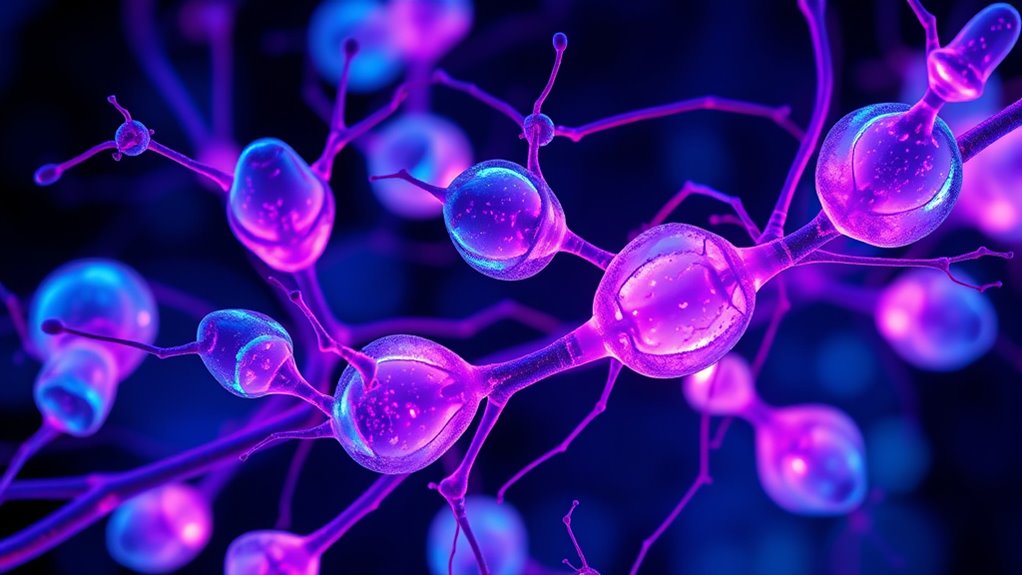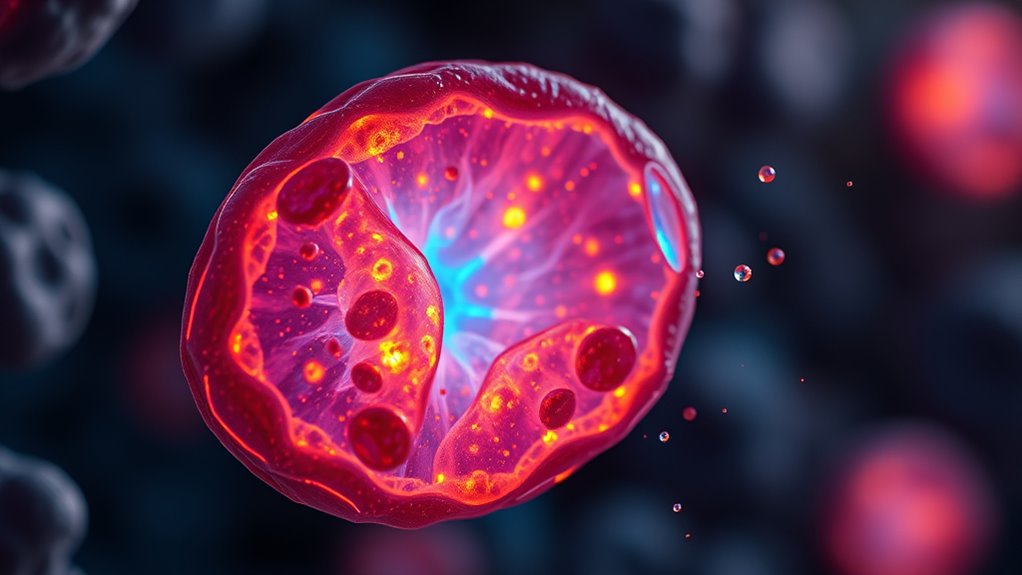Mitochondrial dysfunction plays a key role in aging and related diseases by reducing energy production and increasing oxidative damage. To combat this, focus on strategies like antioxidants, lifestyle changes (healthy diet, exercise), and supplements such as coenzyme Q10 or resveratrol. Advances also include targeting mitochondrial biogenesis and gene therapies. Exploring these options can help you better understand how to maintain mitochondrial health and potentially slow age-related decline. There’s much more to discover for your mitochondrial well-being.
Key Takeaways
- Enhancing mitochondrial biogenesis through PGC-1α activators can restore mitochondrial numbers and improve energy capacity.
- Antioxidant therapies targeting ROS reduce oxidative damage to mitochondrial DNA, lipids, and proteins.
- Supplementation with coenzyme Q10 and NAD+ precursors supports electron transport and mitochondrial function.
- Gene therapy approaches aim to correct mitochondrial DNA mutations and restore genetic integrity.
- Lifestyle interventions like exercise, balanced diet, and stress management promote mitochondrial health and delay dysfunction.
Understanding Mitochondrial Role in Cellular Energy Production

Have you ever wondered how your cells power their activities? The answer lies in mitochondria, often called the cell’s powerhouse. They generate energy through a process called cellular respiration, which relies heavily on mitochondrial DNA, or mtDNA. Unlike nuclear DNA, mtDNA is unique to mitochondria and encodes essential components for energy production. Mitochondrial biogenesis is the process your cells use to produce new mitochondria, ensuring they meet energy demands. When functioning properly, mitochondria efficiently convert nutrients into ATP, the energy currency your cells use. However, as you age, mitochondrial efficiency can decline, leading to less energy and increased cellular stress. Understanding how mitochondrial DNA and biogenesis work together helps reveal how your cells maintain energy and what happens when this system starts to falter. Ongoing research into mitochondrial dysfunction is crucial for developing targeted therapies for age-related decline. Additionally, impairments in mitochondrial function can contribute to various age-related diseases, emphasizing the importance of maintaining mitochondrial health. As science advances, exploring mitochondrial therapies may offer promising avenues to combat aging and improve health span.
The Impact of Mitochondrial Decline on Age-Related Diseases

As mitochondria decline with age, your cells produce less energy, which can weaken tissue function. This decline also leads to increased oxidative damage, harming cellular components. Consequently, more cell death occurs, raising the risk of age-related diseases like neurodegeneration and cardiovascular issues. Additionally, impaired mitochondrial function can negatively affect mitochondrial health, further exacerbating cellular deterioration. Maintaining mitochondrial integrity is therefore vital for preventing age-related decline.
Energy Production Decline
Mitochondrial decline directly impairs the cell’s ability to produce energy, which becomes increasingly problematic as we age. As mitochondrial biogenesis slows, your cells generate fewer healthy mitochondria, reducing overall energy output. Damage to mitochondrial DNA hampers the production of essential proteins needed for efficient electron transport and ATP synthesis. This decline leads to decreased cellular function and contributes to age-related diseases like neurodegeneration and muscle weakness. Without enough functional mitochondria, your cells struggle to meet energy demands, impairing tissue health. Restoring mitochondrial biogenesis and protecting mitochondrial DNA are promising strategies to counteract this decline. By maintaining mitochondrial quality and quantity, you can support energy production and potentially delay or mitigate age-associated health issues. Hearteningly, recent research suggests that promoting mitochondrial health can also improve overall longevity and vitality.
Increased Oxidative Damage
When mitochondrial function declines with age, the balance between reactive oxygen species (ROS) production and antioxidant defenses becomes disrupted, leading to increased oxidative damage. Elevated ROS levels can damage mitochondrial DNA, causing mutations that impair mitochondrial function further. This damage spreads to other cellular components, including lipids and proteins, accelerating cellular aging. Mitochondrial DNA is particularly vulnerable due to its close proximity to the electron transport chain, where reactive oxygen is generated. As oxidative damage accumulates, mitochondria become less efficient, contributing to the development of age-related diseases. You may notice that this decline creates a vicious cycle, amplifying oxidative stress and worsening mitochondrial dysfunction, which highlights the importance of targeting oxidative damage to improve healthspan and combat age-associated conditions. Additionally, antioxidant defenses play a crucial role in neutralizing excess ROS and protecting mitochondrial integrity.
Cell Death Promotion
The decline in mitochondrial function with age directly promotes cell death, contributing to the progression of age-related diseases. Mitochondria influence apoptosis regulation by releasing signals that activate cell death pathways when damaged, leading to programmed cell death. As mitochondria become dysfunctional, there’s an increase in reactive oxygen species, which can trigger necrosis pathways, causing uncontrolled cell death and tissue damage. This imbalance accelerates tissue degeneration and disease development. Mitochondrial decline also impairs energy production, weakening cell survival mechanisms. Understanding how mitochondrial dysfunction influences both apoptosis regulation and necrosis pathways helps identify targets to prevent excessive cell death. This insight is vital for developing therapies that limit tissue damage and slow aging-related disease progression. Additionally, SmartCR innovations are advancing our understanding of mitochondrial behavior and potential interventions. Recognizing the role of mitochondrial quality control mechanisms in maintaining cellular health can inform strategies to enhance mitochondrial resilience in aging tissues, especially considering the impact of reduced noise levels of mitochondrial activity on overall cellular stability.
Molecular Mechanisms Behind Mitochondrial Dysfunction in Aging

As you explore the molecular mechanisms behind mitochondrial dysfunction in aging, it becomes clear that several interconnected processes contribute to this decline. A key factor is impaired mitochondrial biogenesis, which reduces the production of new mitochondria, weakening cellular energy capacity. Additionally, mitochondrial DNA mutations accumulate over time, disrupting the integrity of genetic information essential for proper mitochondrial function. These mutations can impair electron transport chain components, leading to decreased ATP production and further cellular stress. The decline in biogenesis and the buildup of DNA mutations create a vicious cycle, exacerbating mitochondrial dysfunction. This intricate interplay underscores how molecular changes directly impact mitochondrial health during aging, setting the stage for broader cellular deterioration and age-related decline.
Oxidative Stress and Its Link to Mitochondrial Damage

You’re exposed to free radicals that can damage your mitochondria over time. Your body relies on antioxidant defenses to neutralize these harmful molecules, but these systems weaken with age. Understanding how free radical generation and antioxidants interact is key to grasping mitochondrial health during aging. Cybersecurity vulnerabilities can further compromise cellular defenses, highlighting the importance of maintaining robust antioxidant systems. Additionally, lifestyle factors such as diet and exposure to environmental toxins can influence the effectiveness of your antioxidant defenses, impacting overall mitochondrial integrity. Moreover, research indicates that oxidative stress plays a central role in mitochondrial deterioration during the aging process, emphasizing the need for strategies to mitigate its effects.
Free Radicals Generation
Free radicals, particularly reactive oxygen species (ROS), are generated as byproducts of normal mitochondrial respiration. During this process, electrons leak from the electron transport chain, producing ROS that can damage mitochondrial components. You can think of radical scavenging as your body’s way to neutralize these harmful molecules, but when free radical production exceeds this capacity, oxidative stress occurs. This imbalance not only damages mitochondrial DNA, lipids, and proteins but also influences free radical signaling pathways, amplifying cellular stress. As you age, increased ROS levels weaken mitochondrial function, promoting dysfunction. Managing free radical generation through targeted interventions can help reduce damage, preserving mitochondrial integrity. Additionally, antioxidant defenses play a crucial role in neutralizing excess ROS and maintaining cellular health. Understanding this balance is essential for developing therapies aimed at mitigating age-related mitochondrial decline.
Antioxidant Defense Mechanisms
Antioxidant defense mechanisms play an essential role in protecting mitochondria from oxidative stress caused by reactive oxygen species (ROS). When ROS levels rise, these defenses help neutralize harmful molecules, preventing damage to mitochondrial DNA and proteins. Enhancing antioxidant activity can support mitochondrial biogenesis, ensuring the production of healthy mitochondria and maintaining cellular energy. As oxidative stress persists, cells may enter senescence, contributing to age-related decline. Strengthening your antioxidant defenses can slow this process, reduce mitochondrial damage, and improve overall cellular function. Additionally, vetted antioxidant strategies can effectively support mitochondrial health by reducing oxidative damage and promoting cellular resilience. Incorporating natural antioxidants from dietary sources can further bolster these defense mechanisms. By supporting these mechanisms, you help preserve mitochondrial integrity, combat oxidative stress, and potentially delay age-associated cellular senescence. This makes antioxidant strategies a promising target for therapies aimed at mitigating mitochondrial dysfunction during aging.
Natural Compounds and Lifestyle Factors Supporting Mitochondrial Health

Maintaining mitochondrial health is essential for healthy aging, and both natural compounds and lifestyle choices play a significant role in supporting this process. Nutritional supplements like coenzyme Q10 and resveratrol can boost mitochondrial function, while a balanced diet provides essential nutrients. Regular physical activity enhances mitochondrial biogenesis and improves energy production. Lifestyle factors such as adequate sleep and stress management reduce mitochondrial damage caused by oxidative stress. Incorporating these strategies helps preserve mitochondrial integrity and delay age-related decline. You can optimize your mitochondrial health by choosing nutrient-rich foods, staying active, and considering supplements proven to support mitochondrial function. These simple, natural approaches empower you to maintain energy levels and overall vitality as you age. Additionally, engaging in aquatic exercise can provide a low-impact way to boost mitochondrial efficiency and overall fitness.
Pharmacological Strategies to Enhance Mitochondrial Function

Pharmacological strategies offer promising avenues for enhancing mitochondrial function and combating age-related decline. You can use nutrient supplementation to support mitochondrial health, such as compounds like coenzyme Q10, which improve electron transport, or NAD+ precursors that boost cellular energy. These interventions help optimize mitochondrial activity directly. Additionally, certain drugs target mitochondrial biogenesis, encouraging the production of new, healthy mitochondria. Agents like PGC-1α activators stimulate this process, restoring mitochondrial density and function in aging cells. By combining nutrient supplementation with drugs that promote mitochondrial biogenesis, you can potentially slow down age-related deterioration. These pharmacological approaches aim to restore mitochondrial efficiency, reduce oxidative stress, and improve overall cellular health, offering a promising direction in combating mitochondrial dysfunction during aging.
Genetic and Gene Therapy Approaches to Combat Mitochondrial Decline

Advances in genetic and gene therapy strategies present innovative solutions for addressing mitochondrial decline with age. You can harness gene editing techniques to correct mitochondrial DNA mutations, restoring proper function. Promoting mitochondrial biogenesis through targeted gene delivery boosts the production of new, healthy mitochondria, countering age-related decline. These approaches aim to directly modify genetic material, enhancing mitochondrial quality and quantity. Additionally, sleep and dreams may influence mitochondrial health by supporting cellular repair and energy production processes.
Future Directions in Mitochondrial-Targeted Aging Interventions

As research progresses, future strategies for mitochondrial-targeted aging interventions are poised to become more precise and effective. You’ll see advancements in biomarker identification, which will allow you to detect early signs of mitochondrial decline and tailor treatments accordingly. Biomarker detection will enable early diagnosis and personalized treatment plans, improving overall outcomes. Enhancing mitochondrial biogenesis will remain a key focus, helping you to boost mitochondrial numbers and function in aging tissues. Innovative approaches, such as personalized therapies based on genetic and metabolic profiles, will improve intervention outcomes. Combining these strategies with emerging technologies will enable you to target mitochondrial dysfunction more accurately, slowing aging processes and potentially reducing age-related diseases. Additionally, integrating keto-friendly ingredients into metabolic interventions may support overall mitochondrial health by providing essential fats and nutrients. Leveraging appliance testing techniques and energy-efficient strategies from appliances and smart home technology could inspire novel methods for monitoring and optimizing mitochondrial function in clinical settings. Overall, these future directions aim to refine your ability to maintain mitochondrial health, promoting healthier aging trajectories.
Frequently Asked Questions
Can Mitochondrial Dysfunction Be Completely Reversed in Aging Tissues?
You might wonder if mitochondrial dysfunction can be fully reversed in aging tissues. While mitochondrial repair strategies show promise, they often only partially restore function, as aging biomarkers continue to signal damage. Complete reversal remains challenging because some damage is irreversible. However, ongoing research aims to improve therapies, potentially slowing aging processes and enhancing tissue health, even if full reversal isn’t yet achievable.
What Are the Most Promising Emerging Therapies Targeting Mitochondrial Health?
You’re wondering about emerging therapies that target mitochondrial health. Novel antioxidants are showing promise by reducing oxidative stress and protecting mitochondria from damage. Additionally, strategies that promote mitochondrial biogenesis aim to increase the number and function of mitochondria. Together, these approaches could improve cellular energy production and slow aging-related decline, making them some of the most exciting therapies in the pipeline for restoring mitochondrial function.
How Do Mitochondrial DNA Mutations Influence Age-Related Decline?
You might think mitochondrial DNA mutations are tiny glitches, but they actually drive age-related decline. As mtDNA mutation accumulation occurs, it undermines mitochondrial genome stability, leading to less efficient energy production. Ironically, these small genetic errors accumulate silently, gradually impairing cellular functions. So, your aging process is partly fueled by these unseen mutations, making mitochondrial health essential to slowing down age-related decline and maintaining vitality.
Are There Specific Dietary Patterns Optimal for Mitochondrial Maintenance?
You might wonder if certain dietary patterns support mitochondrial health. Nutritional strategies, like calorie restriction, intermittent fasting, and diets rich in antioxidants, can promote mitochondrial function. Dietary interventions focusing on omega-3 fatty acids, coenzyme Q10, and vitamins B and E help maintain mitochondrial integrity. By adopting these patterns, you can enhance energy production, reduce oxidative stress, and potentially slow age-related decline, supporting overall longevity and vigor.
What Role Do Mitochondria Play in Age-Related Neurodegenerative Diseases?
You should know that mitochondria are essential in age-related neurodegenerative diseases because they regulate mitochondrial communication and cellular bioenergetics. When these processes falter, neurons can’t produce enough energy or clear damaging waste, leading to cell death. By maintaining mitochondrial health, you could potentially slow disease progression. Supporting mitochondrial function might be key to developing therapies that protect brain health as you age.
Conclusion
As you explore mitochondrial health, remember it’s the heartbeat of your cellular universe, fueling your life’s journey. When these tiny powerhouses falter, aging accelerates, like a fading lighthouse in a storm. By nurturing your mitochondria through healthy choices and emerging therapies, you hold the key to keeping your inner lighthouse shining bright. Protecting these cellular beacons isn’t just science—it’s your personal voyage toward energy and longevity.









